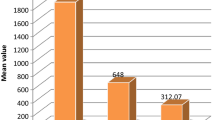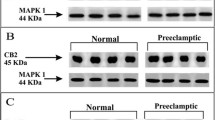Abstract
Purpose
Deficiencies in placental catechol-O-methyltransferase (COMT) and circulating 2-methoxyoestradiol (2-ME) have been shown to be related to early onset preeclampsia. The aim of this study was to investigate levels of 2-ME in the serum and urine of patients with late-onset preeclampsia and to compare those levels to those of normal pregnant women. In addition, we examined placental COMT expression in both groups.
Methods
Fifteen patients with preeclampsia and 15 normal pregnant women were enrolled. 2-ME levels were evaluated by ELISA and placental COMT expression was examined by Western blot analysis.
Results
2-ME levels in serum [median 181.1 pg/mL, interquartile range (IQR) 119.6–244.3 vs. 61.2 pg/mL, IQR 12.0–133.7, respectively, p = 0.004] and urine (median 143.3 pg/mL, IQR 35.0–328.2 vs. 0.5 pg/mL, IQR 0.4–4.6, respectively, p < 0.001) were significantly increased in patients with late-onset preeclampsia compared to those in normal pregnant women at term. There was no significant difference in placental COMT expression between the two groups.
Conclusion
Increased levels of 2-ME in patients with late-onset preeclampsia might be a product of a compensatory mechanism in patients with late-onset preeclampsia.



Similar content being viewed by others
References
Sibai B, Dekker G, Kupferminc M (2005) Pre-eclampsia. Lancet 365(9461):785–799
Roberts JM, Cooper DW (2001) Pathogenesis and genetics of pre-eclampsia. Lancet 357(9249):53–56
Buchbinder A, Sibai BM, Caritis S, Macpherson C, Hauth J, Lindheimer MD, Klebanoff M, Vandorsten P, Landon M, Paul R, Miodovnik M, Meis P, Thurnau G (2002) Adverse perinatal outcomes are significantly higher in severe gestational hypertension than in mild preeclampsia. Am J Obstet Gynecol 186(1):66–71
Huppertz B (2008) Placental origins of preeclampsia: challenging the current hypothesis. Hypertension 51(4):970–975
Kanasaki K, Palmsten K, Sugimoto H, Ahmad S, Hamano Y, Xie L, Parry S, Augustin HG, Gattone VH, Folkman J, Strauss JF, Kalluri R (2008) Deficiency in catechol-O-methyltransferase and 2-methoxyoestradiol is associated with pre-eclampsia. Nature 453(7198):1117–1121
Mabjeesh NJ, Escuin D, LaVallee TM, Pribluda VS, Swartz GM, Johnson MS, Willard MT, Zhong H, Simons JW, Giannakakou P (2003) 2ME2 inhibits tumor growth and angiogenesis by disrupting microtubules and dysregulating HIF. Cancer Cell 3(4):363–375
Vatten LJ, Skjaerven R (2004) Is pre-eclampsia more than one disease? BJOG 111(4):298–302
Hauth JC, Ewell MG, Levine RJ, Esterlitz JR, Sibai B, Curet LB, Catalano PM, Morris CD (2000) Pregnancy outcomes in healthy nulliparas who developed hypertension. Calcium for preeclampsia prevention study group. Obstet Gynecol 95(1):24–28
Kenneth L, Hall DR, Gebhardt S, Grove D (2010) Late onset preeclampsia is not an innocuous condition. Hypertens Pregnancy 29(3):262–270
Masuyama H, Segawa T, Sumida Y, Masumoto A, Inoue S, Akahori Y, Hiramatsu Y (2010) Different profiles of circulating angiogenic factors and adipocytokines between early- and late-onset pre-eclampsia. BJOG 117(3):314–320
Aardema MW, Saro MC, Lander M, De Wolf BT, Oosterhof H, Aarnoudse JG (2004) Second trimester doppler ultrasound screening of the uterine arteries differentiates between subsequent normal and poor outcomes of hypertensive pregnancy: two different pathophysiological entities? Clin Sci (Lond) 106(4):377–382
ACOG practice bulletin (2002) Diagnosis and management of preeclampsia and eclampsia. Number 33. Obstet Gynecol 99(1):159–167
D’Amato RJ, Lin CM, Flynn E, Folkman J, Hamel E (1994) 2-Methoxyestradiol, an endogenous mammalian metabolite, inhibits tubulin polymerization by interacting at the colchicine site. Proc Natl Acad Sci USA 91(9):3964–3968
Salama SA, Kamel MW, Botting S, Salih SM, Borahay MA, Hamed AA, Kilic GS, Saeed M, Williams MY, Diaz-Arrastia CR (2009) Catechol-O-methyltransferase expression and 2-methoxyestradiol affect microtubule dynamics and modify steroid receptor signaling in leiomyoma cells. PLoS One 4(10):e7356
Lee SB, Wong AP, Kanasaki K, Xu Y, Shenoy VK, McElrath TF, Whitesides GM, Kalluri R (2010) Preeclampsia: 2-methoxyestradiol induces cytotrophoblast invasion and vascular development specifically under hypoxic conditions. Am J Pathol 176(2):710–720
Hertig A, Liere P, Chabbert-Buffet N, Fort J, Pianos A, Eychenne B, Cambourg A, Schumacher M, Berkane N, Lefevre G, Uzan S, Rondeau E, Rozenberg P, Rafestin-Oblin ME (2010) Steroid profiling in preeclamptic women: evidence for aromatase deficiency. Am J Obstet Gynecol 203(5):477.e1–e9
Barnea ER, MacLusky NJ, DeCherney AH, Naftolin F (1988) Catechol-O-methyl transferase activity in the human term placenta. Am J Perinatol 5(2):121–127
Palmer K, Saglam B, Whitehead C, Stock O, Lappas M, Tong S (2011) Severe early-onset preeclampsia is not associated with a change in placental catechol O-methyltransferase (COMT) expression. Am J Pathol 178(6):2484–2488
Ghidini A, Salafia CM, Pezzullo JC (1997) Placental vascular lesions and likelihood of diagnosis of preeclampsia. Obstet Gynecol 90(4 Pt 1):542–545
Roten LT, Fenstad MH, Forsmo S, Johnson MP, Moses EK, Austgulen R, Skorpen F (2011) A low COMT activity haplotype is associated with recurrent preeclampsia in a Norwegian population cohort (HUNT2). Mol Hum Reprod 17(7):439–446
Hill LD, York TP, Kusanovic JP, Gomez R, Eaves LJ, Romero R, Strauss JF 3rd (2011) Epistasis between COMT and MTHFR in maternal-fetal dyads increases risk for preeclampsia. PLoS One 6(1):e16681
Lim JH, Kim SY, Kim do J, Park SY, Han HW, Han JY, Lee SW, Yang JH, Ryu HM (2010) Genetic polymorphism of catechol-O-methyltransferase and cytochrome P450c17alpha in preeclampsia. Pharmacogenet Genomics 20(10):605–610
Conflict of interest
We declare that we have no conflict of interest.
Author information
Authors and Affiliations
Corresponding author
Rights and permissions
About this article
Cite this article
Seol, HJ., Cho, GJ., Oh, MJ. et al. 2-Methoxyoestradiol levels and placental catechol-O-methyltransferase expression in patients with late-onset preeclampsia. Arch Gynecol Obstet 287, 881–886 (2013). https://doi.org/10.1007/s00404-012-2663-1
Received:
Accepted:
Published:
Issue Date:
DOI: https://doi.org/10.1007/s00404-012-2663-1




